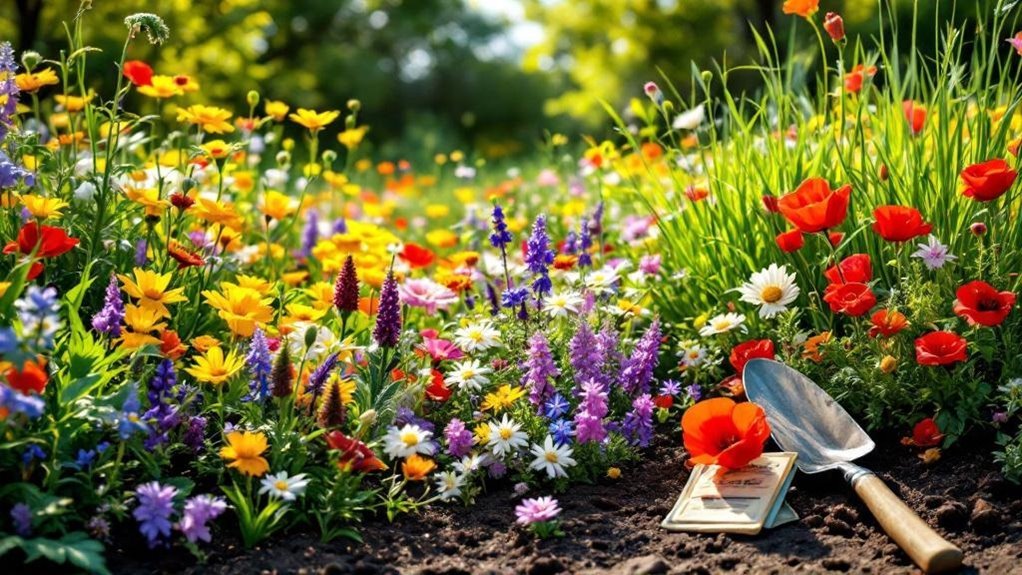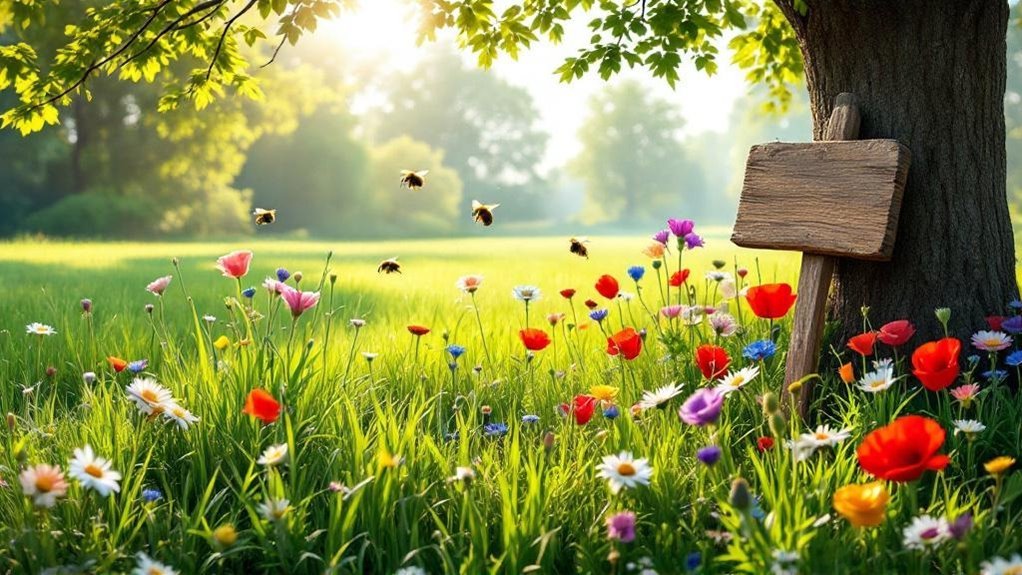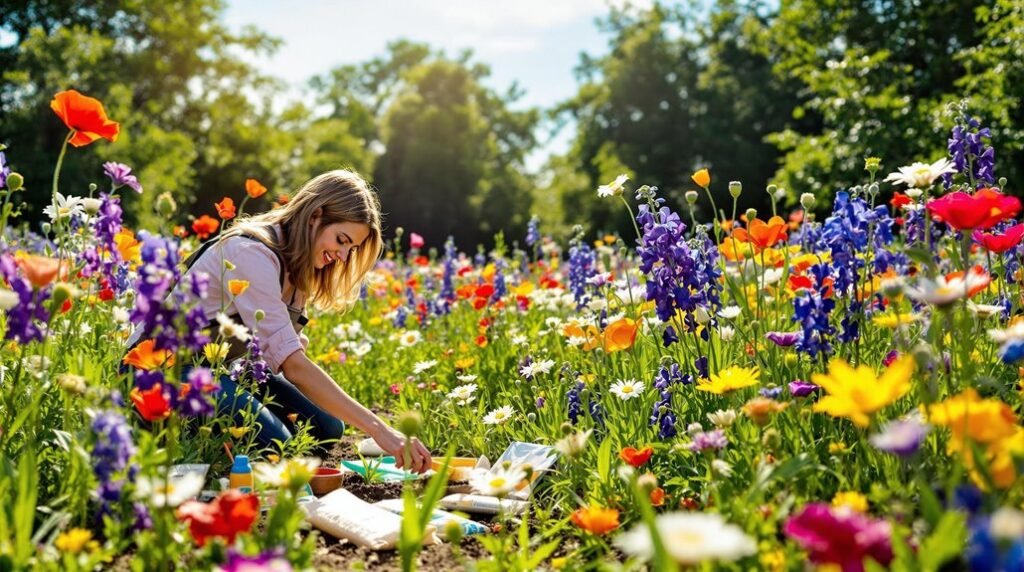If you’re thinking about transforming part of your yard into a wildflower meadow, you’ll want to start by understanding your site’s conditions and planning carefully. It’s not just about scattering seeds; you’ll need to take into account sun exposure, soil quality, and existing vegetation. Getting these basics right sets the stage for a thriving meadow that supports local wildlife. But before you grab a seed mix, there are key steps to prepare your space effectively.
Assessing Site Conditions for Your Meadow
Before planting your wildflower meadow, you’ll need to carefully evaluate your site’s conditions. Start by examining sunlight exposure; most wildflowers need at least six hours of direct sun daily.
Next, analyze soil conditions by identifying soil type—whether sandy, clay, or loam—and moisture levels, which can range from dry to wet.
Assess soil type and moisture to choose wildflowers that will thrive in your meadow.
Take note of existing plants, as they reveal clues about your soil type and moisture, helping you select compatible native species.
It’s essential to remove invasive species during site preparation since they compete with native wildflowers and hinder meadow growth.
Use resources like GoBotany to identify plants and manage invasives effectively.
Preparing the Ground for Planting
Once you’ve evaluated your site’s conditions and cleared out invasive species, it’s time to prepare the ground for planting. Proper soil preparation is essential to reduce weed pressure and guarantee your wildflower seeds thrive. Here’s how to get started:
- Remove existing grass and weeds by hand or using no-till methods like black plastic or mulch to suppress weeds without disturbing soil structure.
- Consider planting cover crops such as buckwheat or clover in the season before sowing to improve soil health and further suppress weeds.
- Confirm the soil is well-drained and the site receives full sun, as these conditions favor healthy growth when planting wildflowers.
Selecting Native Wildflower and Grass Species

When choosing wildflowers and grasses, focus on species native to your area since they’re best suited to local climate and soil conditions.
Select a diverse mix of native wildflower and grass species, including perennials, annuals, and biennials, to boost biodiversity and guarantee seasonal color.
Native grasses should make up 50-80% of your meadow’s plant composition—they provide structure, reduce weeds, and support wildlife habitats.
Research bloom times to create staggered flowering, which attracts pollinators and keeps your meadow vibrant throughout the growing season.
Use regionally appropriate seed mixes and consult local native plant organizations to avoid invasive species and guarantee your selection thrives.
This thoughtful approach helps establish a sustainable, healthy wildflower meadow that benefits both you and the environment.
When and How to Sow Seeds
Although sowing wildflower seeds requires careful timing, doing it in the fall—between late September and early December—gives them the cold exposure they need to germinate effectively.
This fall planting takes advantage of the ideal time when soil temperature supports seed germination. To sow seeds properly, mix wildflower mixes with sand for even seed distribution and prevent clumping.
Guarantee good seed-to-soil contact by sowing in two directions, north-south then east-west. After scattering, lightly rake or roll the soil to press seeds in, boosting moisture retention.
Finally, apply a thin layer of mulch, like straw, to protect seeds without blocking light, aiding germination.
Follow these steps:
- Mix seeds with sand and sow in two directions.
- Press seeds into soil for moisture retention.
- Add mulch to secure seeds and enhance germination.
Converting Existing Lawns Into Meadows

Transforming your existing lawn into a wildflower meadow starts by stopping regular mowing to let native plants take hold and flourish. Begin by removing non-native species that compete with your meadow’s growth. Use soil solarization to clear existing grasses without herbicides. Sow wildflower seeds or plant small native plants in bare patches during early spring or fall for best growth. Creating meandering paths encourages wildlife interaction, enriching your diverse ecosystem.
| Step | Purpose |
|---|---|
| Stop mowing | Allows native plants to establish |
| Remove non-native species | Reduces competition for resources |
| Soil solarization | Prepares soil for wildflower seeds |
This approach guarantees successful converting existing lawns into a thriving wildflower meadow.
Enhancing Old Fields With Native Plants
How do you breathe new life into an old field? Start by evaluating the existing plant community to identify and remove invasive species that could choke out native plants.
Next, prepare the site by using soil solarization or sheet mulching to eliminate unwanted grasses without herbicides. Then, enhance biodiversity by planting small native plants or sowing seeds in bare patches during early spring or fall.
Prepare your site naturally with solarization or mulching, then plant native seeds or small plants in early spring or fall.
Here’s a simple plan to enhance old fields with native plants:
- Reduce mowing frequency to allow native species to establish and thrive.
- Monitor the area regularly for invasive species and manage their growth.
- Fill gaps in the existing plant community with diverse native plants to create a diverse habitat.
Planting Juvenile Plants Into Established Meadows
Once you’ve nurtured an old field with native plants, adding juvenile plants into an established meadow can further enrich its diversity and resilience.
When planting, choose small, sturdy native plants suited to your meadow’s conditions. Early spring or fall is ideal to align with natural growth cycles and boost survival.
Space juvenile plants carefully to avoid overcrowding and allow room for mature growth. Water them thoroughly after planting to encourage strong root establishment, especially during dry spells.
Monitor your meadow closely for signs of stress or competition from existing plants. Be ready to manage any weeds that might threaten your new additions.
With thoughtful planting and attentive care, your established meadows will flourish with vibrant, healthy juvenile plants.
Managing Weeds and Invasive Species
Keeping invasive species in check is crucial to maintaining a healthy wildflower meadow. You’ll need to regularly inspect your meadow and promptly remove aggressive weeds to protect native plants and preserve biodiversity.
Here are three effective strategies to manage weeds and invasive species:
- Use manual weeding or spot-treat with herbicides carefully, following label instructions to avoid damaging wildflowers.
- Apply soil solarization or sheet mulching to eliminate tough lawn grasses and perennial weeds before planting native species.
- Follow a mowing regime that supports wildflowers’ flowering and seed set—mow no more than once a year at the end of the growing season.
Long-Term Care and Maintenance of Your Meadow
Although establishing your wildflower meadow takes time, maintaining it properly guarantees long-term health and biodiversity. Focus on annual mowing after flowering to support seed set and curb invasive species. Monitor soil moisture to protect wildflower seedlings, especially during dry spells. Remove invasive species promptly to let native plants thrive. Leave parts un-mown each year to provide wildlife habitat and enhance ecosystem resilience. Remember, it may take years for your meadow to fully establish and for biodiversity to flourish.
| Maintenance Task | Recommended Action |
|---|---|
| Mowing | Once annually, post-flowering |
| Invasive Species Control | Regular monitoring and immediate removal |
| Soil Moisture Management | Check regularly, especially for seedlings |
Frequently Asked Questions
Can You Just Throw Wildflower Seeds on the Ground?
You can throw wildflower seeds on the ground, but without preparing the soil, removing weeds, and ensuring good seed-to-soil contact, your seeds probably won’t germinate well or grow into a healthy, vibrant meadow.
How Do I Turn My Yard Into a Wildflower Meadow?
You’ll want to clear grass and weeds, prepare well-drained soil, then sow native wildflower seeds in fall or spring. Water consistently until seedlings grow, and manage weeds gently to help your meadow thrive naturally.
What Are the Disadvantages of a Wildflower Meadow?
You might face challenges like time-consuming maintenance, slow flower growth, and weed control struggles. Also, pests and invasive species can disrupt your meadow, and choosing the right native plants for your soil and light can be tricky.
How Long Does It Take to Grow a Wildflower Meadow?
It takes you about three years to grow a wildflower meadow. The first year focuses on prepping and controlling weeds, the second year seedlings establish, and by the third year, vibrant blooms usually flourish beautifully.
Final Thoughts
Establishing a wildflower meadow takes patience and care, but the rewards are well worth the effort. By evaluating your site, preparing the ground properly, selecting native species, and managing weeds, you’ll create a vibrant, thriving habitat. Remember, Rome wasn’t built in a day—your meadow will grow stronger each season with consistent care. Stick with it, and soon you’ll enjoy a beautiful, buzzing oasis right in your own backyard.
